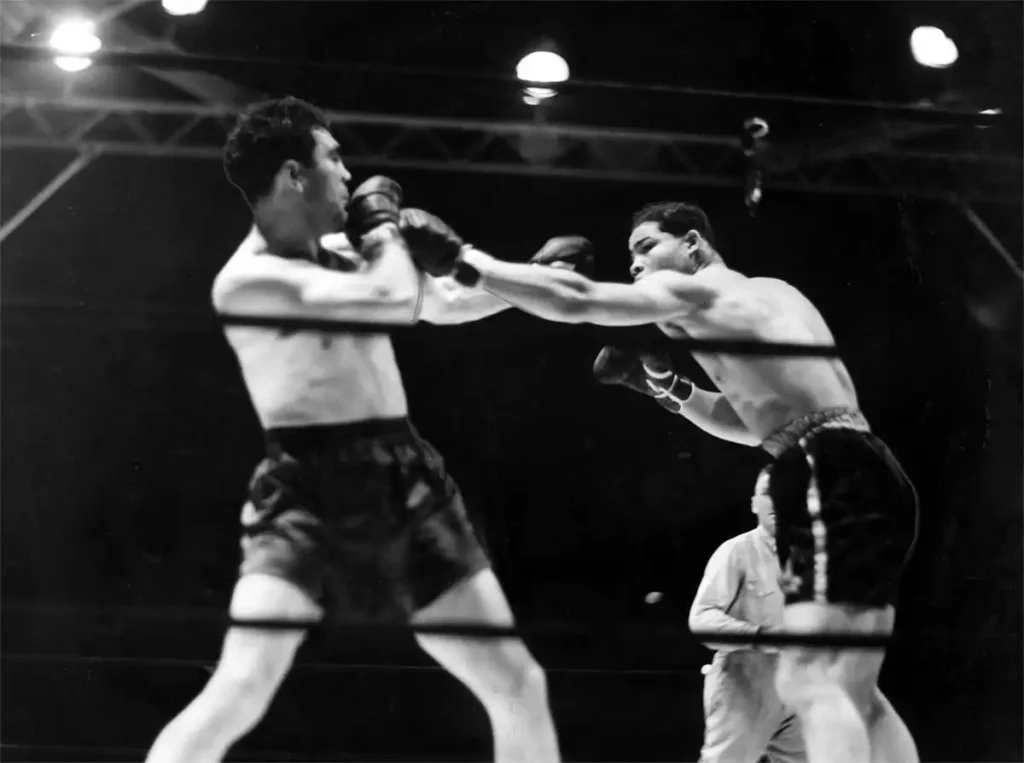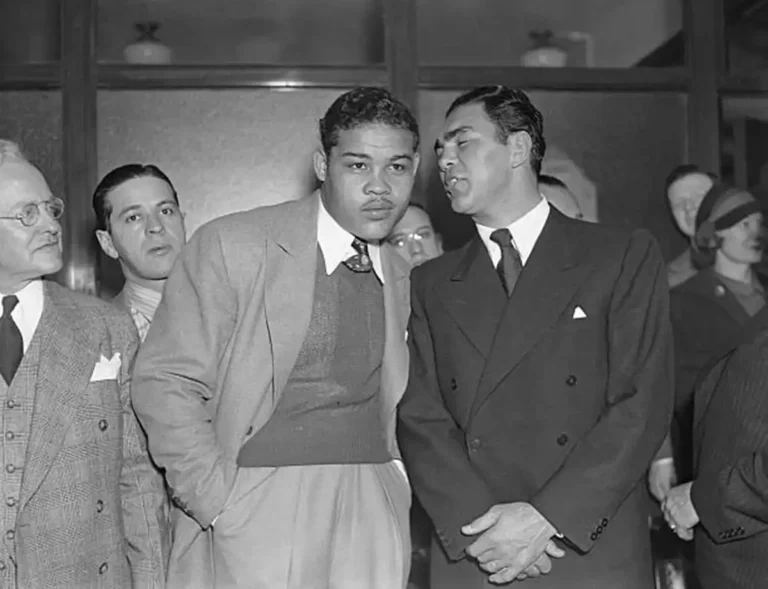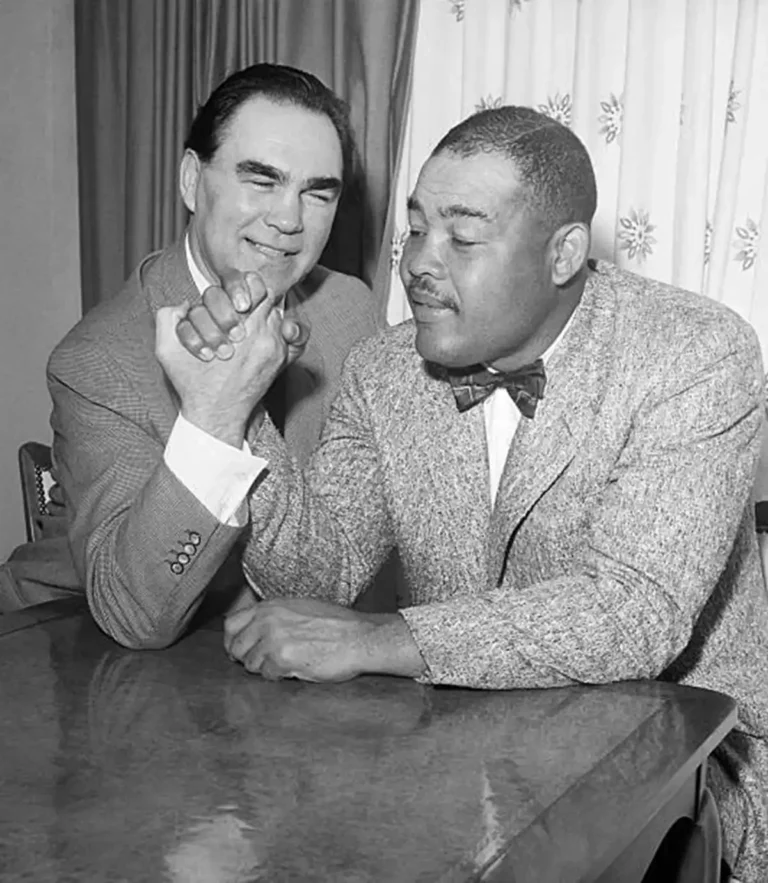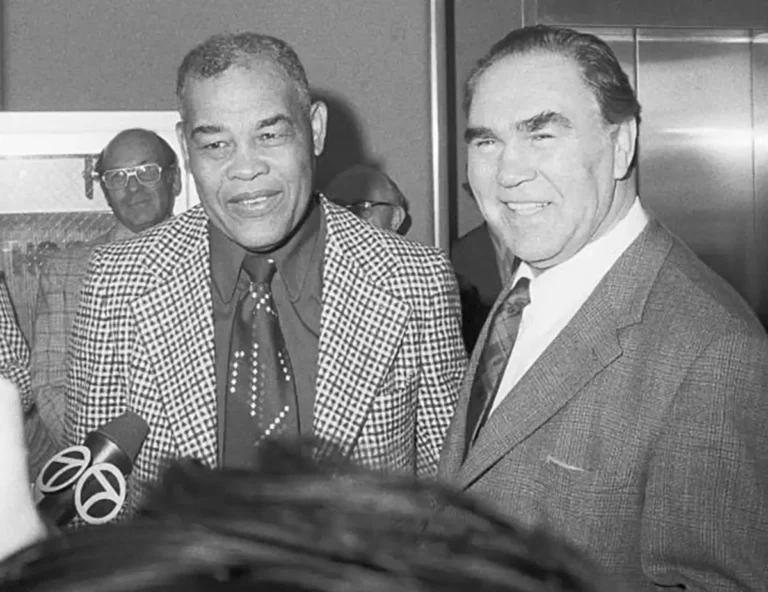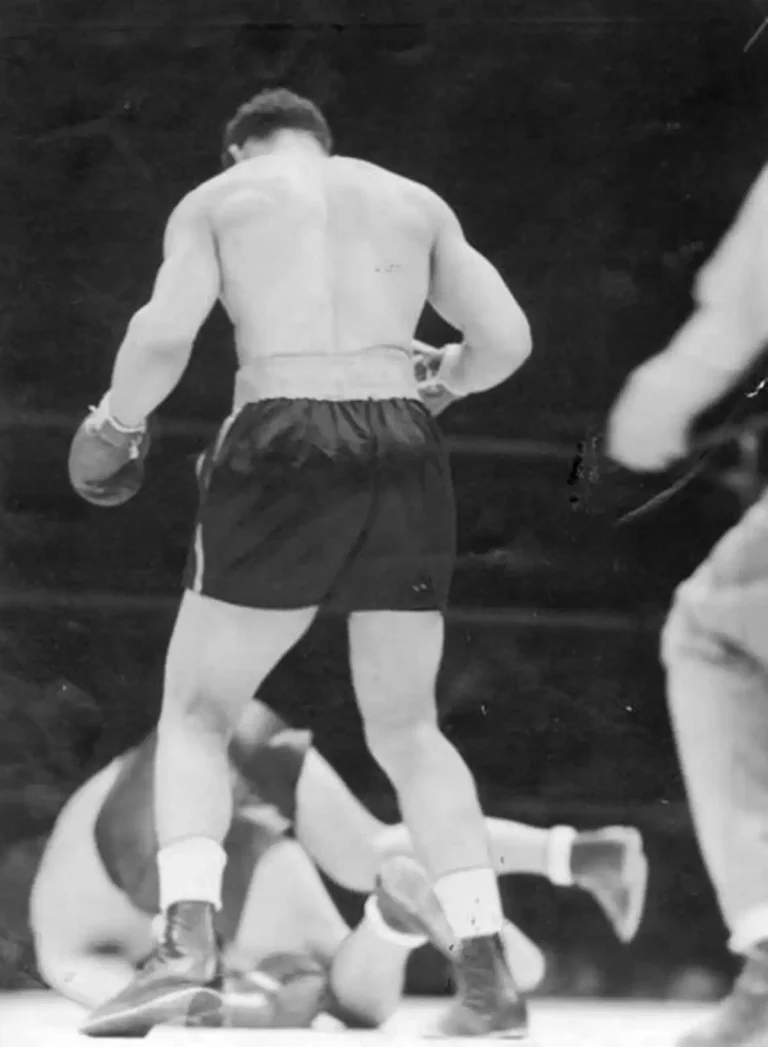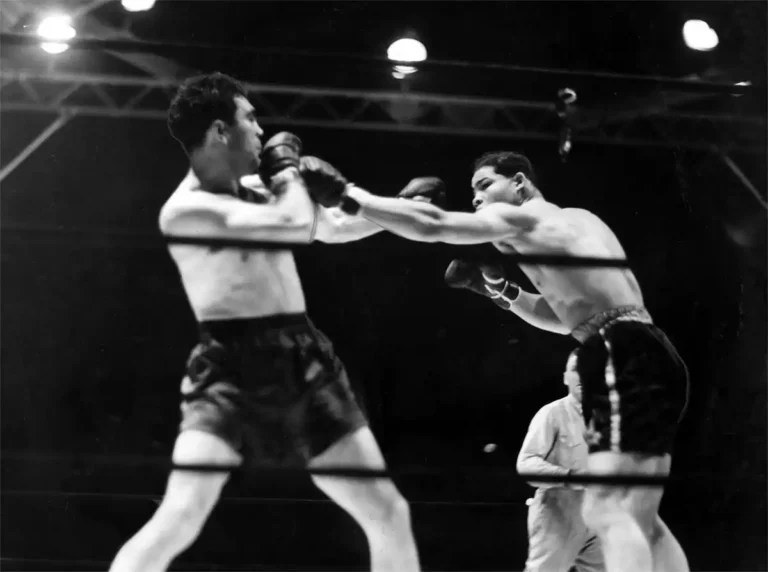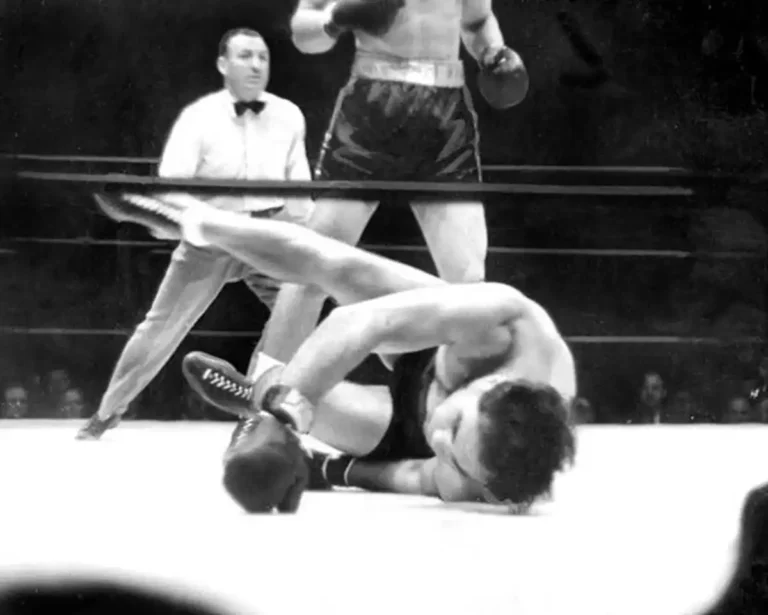I. Introduction: The Ring as a Geopolitical Microcosm
In the mid-1930s, the world struggled under the dual pressures of economic devastation stemming from the Great Depression and the ominous rise of ideological conflicts, specifically the challenge presented by totalitarian fascism to established democratic liberalism. Within this strained geopolitical environment, the sport of heavyweight boxing acquired profound symbolic significance. Historically, the heavyweight champion was viewed as embodying the status of the “toughest man in the world,” a title with great resonance for nationalist leaders seeking to project ideological strength. It was against this backdrop of global tension that the first professional encounter between American boxer Joe Louis and German contender Max Schmeling unfolded.
The event took place at Yankee Stadium in New York City on June 19, 1936, slightly delayed due to rain. Louis, then only 22 years old, was the undefeated “Brown Bomber” and a staggering 10-to-1 favorite. Schmeling, 30, was a former champion but was generally regarded as past his prime. The expectation was a swift victory for the young American phenom. The outcome, however, was a shock: Schmeling delivered a knockout in the twelfth round, marking Louis’s first professional defeat.
This upset immediately transcended the realm of athletics, transforming the sporting event into a critical clash of global ideologies—a struggle that the contemporary press often framed as democracy versus fascism. The historical power of this event lies in the profound, often overlooked, ideological irony inherent in the two combatants’ national origins. Louis hailed from LaFayette, Alabama, and had relocated to Detroit to escape the entrenched, pervasive racism of the Jim Crow South. He represented a nation defined by systemic white supremacy and racial caste. Schmeling, conversely, was the representative of Nazi Germany, a nation explicitly promoting the doctrine of Aryan racial purity and superiority.
The Nazi regime, led by Adolf Hitler, had initially been hesitant about the bout, fearing a Louis victory would undermine their propaganda goals, especially in the lead-up to the highly politicized 1936 Berlin Olympics. The Nazi Propaganda Ministry, headed by Joseph Goebbels, had ordered party newspapers to initially bury coverage of the fight. This pre-calculated contingency demonstrated the regime’s strategy: if Schmeling lost, the news would be minimized to protect the narrative of Aryan strength ahead of the Olympics, where they planned to project a false image of a “peaceful, tolerant Germany”. However, Schmeling’s victory instantly shifted the calculation, allowing Goebbels to declare it a “triumph for Germany and Hitlerism”. The victory was immediately weaponized, giving the Nazis a doubly potent propaganda tool: a defeat of an American symbol and a defeat of a Black man, validating the core tenets of their racist doctrine just months before the international scrutiny of the Olympic Games.
The central paradox of this historical nexus is that both men emerged from nations dedicated to state-sanctioned racial hierarchy—two very different worlds, yet defined by striking and surprisingly similar systems of racial oppression. However, their personal integrity and conduct throughout their careers, particularly their eventual powerful friendship, defied and ultimately indicted the dehumanizing ideological mandates imposed upon them by their respective states.
II. The Contenders: Burden and Exploitation in the 1930s
A. Joe Louis: The Brown Bomber and the Weight of Race
Joseph Louis Barrow was born in rural Alabama and represented the large migration of rural Southern black people to the urban North, escaping the iron chains of Jim Crow. Jim Crow laws, established between 1874 and 1975, were statutes designed to maintain a racial caste system, enforcing segregation, preventing Blacks from obtaining equal resources, and maintaining white supremacy. This oppression was underpinned by scientific racism and negative stereotypes. In the segregated South, Black people lived in fear of racially motivated violence and were barred from public places and many professional opportunities.
When Louis launched his professional career in 1934, he swiftly became the most significant African American athlete of his age, marking the return of a successful Black heavyweight fighter since Jack Johnson. He was an unparalleled source of pride and inspiration for African Americans; his very success was interpreted as a physical, direct challenge to Jim Crow oppression. His friend Walter Smith remarked that Louis’s defeat in 1936 left “Everybody sick,” illustrating how his personal career was intrinsically linked to the collective fight for Black dignity.
Despite his status as a Black icon, Louis was strategically adopted by the broader white American public and the government, particularly as the threat of Nazism grew. The US establishment began leveraging Louis as a potent, visible symbol of American democracy and anti-fascism. This elevation represented a calculated political manipulation. By promoting Louis as a nationwide hero, the US government could project an image of racial openness globally, effectively using him as a shield to divert international scrutiny away from the violent realities of domestic Jim Crow segregation. This allowed the nation to maintain a strategic hypocrisy: championing Louis’s race abroad to counter the narrative of Aryan superiority while minimizing or ignoring the systemic racism he and millions of African Americans faced at home. Louis’s fight was therefore a contest against two forms of white supremacy: the ideological fascism of Germany and the legalized oppression of his home country.
B. Max Schmeling: An Unwilling Tool of the Reich
Max Schmeling, nicknamed the “Black Uhlan of the Rhine,” was intrinsically linked to the rising fortunes of the National Socialist Party, even though he was not a political ideologue. Following his unexpected 1936 victory, the Nazi regime instantly seized upon him as a hero. Propaganda Minister Goebbels utilized Schmeling’s success as “a perfect example of German supremacy over the rest of the world”. The Nazi weekly journal Das Schwarze Korps commented that Schmeling’s success was “not only sport. It was a question of prestige for our race”. Parades and rallies were ordered in his honor, and he received favored treatment, becoming personally known to Hitler and other powerful regime figures.
However, the historical record demonstrates that Schmeling maintained a moral core that resisted the party’s attempts at complete ideological co-option. To Hitler’s chagrin, Schmeling steadfastly refused to join the Nazi party, refusing to participate in the exploitation of his accomplishments by Nazi propagandists. Furthermore, he maintained unwavering loyalty to his long-time Jewish manager, Joe Jacobs, despite intense political pressure from the regime to dismiss him. This loyalty was a subtle but profound act of moral subversion within a totalitarian system, directly contradicting the foundational “Aryans only” policy instituted in German athletic organizations in April 1933. Schmeling placed his professional relationships and personal integrity above the racist dictates of the state, confirming that, from the beginning, his personal character was resistant to the dehumanizing political roles assigned to him.
This resistance placed Schmeling in a difficult position, forcing him into a type of devil’s bargain. As a public representative of Germany overseas, he was utilized by the Nazis as a diplomatic mouthpiece. In 1933, Hitler reportedly instructed Schmeling to counter negative international press, resulting in the boxer telling American journalists that conditions in Germany were “okay and quiet” and denying that Jewish people were being persecuted. Schmeling’s political association was, therefore, one of state coercion and ideological exploitation, even when he was celebrated as a national hero.
III. The Upset in Yankee Stadium: The Mechanics of the 1936 Defeat
A. Pre-Fight Dynamics and Underestimation
The primary factor contributing to the shocking outcome of the 1936 non-title bout was the stark difference in preparation and approach. Louis, enjoying a meteoric rise to the top of the sport, had won his first 27 professional bouts, 23 by knockout. Viewed as invincible, Louis approached the fight with a degree of complacency, spending significant time on the golf course rather than focusing intently on training.
In contrast, Schmeling, considered a decided underdog, prepared with meticulous intensity. He studied Louis’s style thoroughly, watching hours of film “backwards and forwards,” literally and figuratively dissecting the younger champion’s technique. Schmeling’s deep analysis revealed a crucial, exploitable weakness: Louis had a habit of dropping his left hand immediately after throwing a jab, leaving a split-second window of vulnerability. Schmeling planned to withstand Louis’s powerful early assault long enough to capitalize on this flaw with his devastating right hand.
The tactical triumph of Schmeling’s meticulous study over Louis’s reliance on raw talent resonated politically at the time. Louis’s defeat represented the danger of complacency and underestimation in the face of an organized, meticulously prepared, and strategically focused totalitarian threat, paralleling contemporary fears about the rise of Nazi Germany. The 1936 fight, spanning twelve rounds, demonstrated that technical discipline and strategic preparation could overcome expected outcomes and raw aggression.
B. The Course of the Fight and the Knockout
The bout, which took place on June 19, 1936, saw Schmeling successfully execute his game plan. Though Louis remained busy, Schmeling’s constant jab and careful counterpunching neutralized Louis’s attempts at a knockout victory. Louis, struggling with slight eyesight trouble, found it impossible to land the decisive blow.
By the twelfth round, the fight had turned decisively in Schmeling’s favor, placing him far ahead on the judges’ scorecards. The strategic opening Schmeling had sought finally materialized. He landed a crippling right hand to Louis’s body, immediately followed by a powerful right cross to the jaw. Louis fell near his corner, marking the first time in his professional career that he had ever been knocked down, let alone knocked out. Referee Arthur Donovan counted Louis out, confirming the shocking upset.
This defeat was critical to Louis’s career trajectory. It was his only knockout defeat during his first professional run; the only other occurred fifteen years later against Rocky Marciano, when Louis was considered a faded champion. Schmeling’s victory, achieved through technical mastery, allowed him to celebrate an upset victory without reservation.
Table Title: Joe Louis vs. Max Schmeling I (1936) – Tactical and Political Overview
Category
Joe Louis (The Brown Bomber)
Max Schmeling (Black Uhlan of the Rhine)
Political Significance
Pre-Fight Status
Undefeated (24-0), 10-to-1 favorite.
Former champion (48-7-4), considered past prime.
Low initial stakes for Germany, leading to Goebbels’s initial cautious approach to media.
Strategy
Relied on speed and power; suffered from poor preparation and complacency.
Meticulous study; exploited Louis’s habit of dropping his left arm for the counter right.
Tactical victory validated the Nazi narrative of disciplined “German superiority” over perceived African “savagery”.
Result
Knocked out in Round 12. First professional KO defeat.
Victory by KO.
Fueled Nazi propaganda machine; provided Louis with the necessary motivation and humility for the future rematch.
C. Immediate Aftermath and Reaction
The loss of the “invincible” Louis sent waves of shock across the United States. The New York Post declared, “An idol fell… and the crashing was so complete, so dreadful and so totally unexpected that it broke the hearts of the Negroes of the world”. The profound despair felt by the African American community underscored the extraordinary symbolic burden placed upon Louis. His athletic performance was tied directly to the community’s fight for dignity, meaning his defeat was interpreted not merely as a sports loss but as a defeat in the broader racial war against white supremacy. The Pittsburgh Courier, a prominent Black newspaper, published a tribute headlined, “Joe Louis, We Are With You,” confirming the collective nature of the crisis.
In Germany, the reaction was predictably one of euphoria. Minister of Propaganda Joseph Goebbels ensured Schmeling’s victory was instantly broadcast, proclaimed as a triumph for “Hitlerism” and providing proof of “prestige for our race”. The fight film, titled “Schmeling’s Victory: A German Victory,” was widely shown throughout Germany by Hitler’s decree to promote Nazi nationalism. Schmeling was flown back aboard the Hindenburg and received as a national hero. His victory provided timely, explicit validation for the racial doctrines the Nazis were actively implementing.
IV. Comparative Anatomy of Racial Supremacy (1930s)
The juxtaposition of Louis and Schmeling offered a platform for the conflict between democracy and fascism. However, a deeper analysis reveals that the foundation of the conflict was not democracy versus totalitarianism, but two competing expressions of state-sanctioned racial supremacy. Both Jim Crow America and early Nazi Germany were shaped by the global movement of pseudo-science and eugenics, designed to legitimize violence and racial hierarchy. The goal in both nations was the systemic limitation and marginalization of a targeted minority group—African Americans in the US and Jewish people in Germany—through legal and social mechanisms.
A. The American Model as a Blueprint for the Reich
A critical element of this comparative study is the established intellectual and legal exchange between the two systems. Contrary to popular historical belief, the Nazi regime did not develop its foundational racial laws in a vacuum. Analysis of the planning meetings for the notorious Nuremberg Laws in 1935 reveals that Nazi legal architects explicitly studied and discussed American race law as a direct model for structuring their new racial regime.
In a June 1934 meeting involving figures such as Minister of Justice Franz Gürtner and future People’s Court President Roland Freisler, detailed memos on American race law were reviewed. Freisler, one of the most radical Nazis present, championed the lessons American approaches held for Germany. He noted that US jurisprudence “would suit us perfectly” with one major exception: they would need to adapt it to specifically target Jews, who were not consistently reckoned among “coloreds” in the American model. This stunning historical finding transforms the surface-level “irony” of the Louis-Schmeling context into a causal link. The decentralized Jim Crow system was not merely similar to Nazism; it functioned as an internationally accessible, functional blueprint for achieving state-sponsored racial engineering and legal segregation.
B. Mechanisms of Segregation and Legal Definition
The operational mechanics of both systems displayed profound similarities in the 1930s:
- Racial Codification: Both states employed a “blood” standard to determine legal identity and enforce segregation. In the US, particularly in states like Virginia, definitions were rigorous, sometimes tracing “blood” standards to require “no trace whatsoever of ‘blood’ other than Caucasian”. The Nazi regime also adopted a “blood” standard, codified in the Nuremberg Laws, tracing Jewish heritage back three generations. Although the Nazi standard was arguably less stringent than some US state laws due to the challenges of identifying assimilated individuals, the core mechanism—state use of pseudo-science to legally define and strip citizenship based on heredity—was parallel.
- Physical and Social Segregation: Jim Crow laws were codified at the state and local levels to separate Black and white races in public spaces, including restaurants, hotels, schools, and transportation. Early Nazi anti-Jewish policies similarly began as municipal prohibitions, banning Jewish people from public places, paralleling the segregationist aims common in Houston and other Jim Crow cities.
- Political Deprivation: Jim Crow laws, utilizing literacy tests for voters who lacked education and “grandfather clauses” (preventing descendants of non-voters from registering), effectively disenfranchised African Americans. The Nuremberg Laws accomplished a similar political deprivation by stripping German Jews of citizenship and political rights.
C. The Critical Divergence
While the structural similarities are evident, the historical trajectories diverged sharply. Jim Crow America, though deeply violent and founded on racial terror (including lynching), was a decentralized system maintained by state laws and federal inaction. Conversely, Nazi Germany was a centralized, totalitarian state that, after the Nuremberg Laws of 1935, rapidly universalized and radicalized its anti-Jewish policies via federal decrees.
The fundamental difference lies in the planned, industrialized acceleration of violence in Nazi Germany that led directly to widespread, state-sanctioned murder and genocide in the 1940s—the Holocaust. This ultimate trajectory was one that the US, despite its profound racial injustices, did not follow. However, the critical point for the 1936 fight narrative is that the US, in its effort to posture as the global standard-bearer of democracy against Hitler, had to selectively champion Louis’s race abroad while simultaneously maintaining his suppression at home. This strategic hypocrisy was the necessary cognitive dissonance for waging ideological war against fascism, proving that Louis’s rise was as much a tool of geopolitical manipulation as Schmeling’s downfall would later be for Hitler.
V. The Rematch (1938): The Battle of the Century
A. The Context of Mounting Global Crisis
The political and military climate had deteriorated significantly by 1938. Fascist expansionism, including Italian incursions and Hitler’s territorial ambitions, was escalating. The rematch for the world heavyweight title was no longer simply a sporting contest; it was profoundly political, representing the struggle between two opposing global systems.
Louis, who had won the heavyweight title by knocking out James J. Braddock in 1937, still carried the sting of his first defeat. He famously declared that his title felt “hollow without beating Schmeling”; the eventual victory over the German would be the moment he truly considered himself world champion.
B. The Symbolism of the Contest
The media and governments explicitly cast the 1938 bout as an ideological confrontation. Louis was depicted as the representative of the United States and democracy, while Schmeling was projected as the physical symbol of Nazi Germany and fascism. The fight took on profound, existential importance for the African American community, who understood that a loss would validate the Nazi doctrine of Aryan superiority and reinforce accusations that Black people were “lower types of human beings”. Poet Maya Angelou recalled the community’s fear: “If Joe lost we were back in slavery and beyond help. It would all be true”.
The magnitude of the event was massive, transcending previous sporting events. Seventy thousand spectators crowded Yankee Stadium, and an estimated 100 million people tuned in via radio across the globe.
C. The Decisive Victory
The rematch, held on June 22, 1938, did not resemble the technical, drawn-out affair of 1936. Louis entered the ring with a renewed purpose and singular focus, driven by the knowledge that he was fighting for something much larger than himself.
The fight was brief and brutally decisive. Louis unleashed a relentless, tireless barrage against Schmeling. Louis immediately dropped the German with a right hook to the face after connecting on multiple hooks and a body blow that caused Schmeling to cry out audibly in pain. Louis scored a devastating knockout in the first round, lasting just over two minutes.
The violent brevity of the 1938 match was a symbolic reversal of the 1936 loss. The technical deficiency that allowed the 1936 upset had been replaced by focused, overwhelming moral resolve. Louis’s victory was perceived globally as a victory for liberty and human dignity over fascism. The immediate aftermath in the United States was celebratory, most notably in Harlem, where 100,000 people poured onto the streets in celebration, interpreting the victory as a collective triumph against white supremacy, both foreign and domestic. Schmeling was so badly injured that he spent a week recuperating in a New York hospital.
D. Schmeling’s Fall from Grace and Political Consequences
Schmeling’s loss had immediate and severe political repercussions in Germany. Having failed to deliver the necessary ideological validation for the regime, he instantly fell out of favor with Hitler. The consequences confirmed that his association with the party was one of coercion: Hitler exacted revenge by drafting Schmeling into the German army as a paratrooper. Schmeling served in combat roles, including the invasion of Crete. This act demonstrated the ultimate fragility of celebrity status within a totalitarian regime; even favored heroes are politically disposable when they cease to serve the narrative of racial superiority. Schmeling’s punishment for his defeat confirms that the ideology of Nazism demanded not just allegiance, but consistent, unfailing success.
VI. The Transcendence of Character: Gentlemanly Conduct and Enduring Friendship
The profound historical significance of the Louis-Schmeling narrative is ultimately defined not by the ideological battle manufactured by their governments, but by the enduring personal respect and friendship established between the two men. Both Louis and Schmeling displayed a powerful sense of dignity that deliberately clashed with the racist roles their governments assigned to them. Louis held his title with dignity and grace, standing as a bulwark against Jim Crow. Schmeling, though coerced into representing the Reich, continued to demonstrate moral courage by refusing to join the Nazi party and maintaining his Jewish manager. He later risked his own life to help save Jews from the Nazis.
The political rivalry that reached its apex in 1938 transitioned over the ensuing decades into a relationship of genuine, mutual respect. This eventual bond offers a powerful counter-narrative to the intense ideological hatred manufactured by the media and governments of the 1930s.
In the later stages of his life, Louis, despite his massive wartime fundraising and symbolic service for the United States, struggled immensely with financial hardship, largely due to massive tax debt owed to the Internal Revenue Service. He died a “pauper and a relatively forgotten American hero”. Max Schmeling, however, prospered in post-war Germany, having secured a wealthy business as a Coca-Cola franchise holder.
Schmeling’s response to Louis’s plight finalized the moral argument of their history. He frequently provided financial support to Louis, helping the former champion “make ends meet”. This act reversed the traditional political power dynamic: the representative of the democratic nation was financially ruined, while the man coerced into representing the fascist state found economic security and provided aid.
The ultimate demonstration of Schmeling’s gentlemanly conduct and enduring loyalty came after Louis’s death in 1981. Schmeling traveled to the United States, served as a pallbearer, and helped pay for Louis’s military funeral. Schmeling’s actions demonstrated that the personal, human connection forged between them was more resilient and morally meaningful than the coercive political forces that sought to exploit them for ideological gain. This enduring loyalty stands as a profound indictment of the manufactured hatred and racial hierarchies that both the Jim Crow South and Nazi Germany desperately sought to enforce.
Gallery
VIDEO

Louis and Schemelling Fight Footage
VII. Conclusion: A Legacy Forged in Conflict
The 1936 boxing match between Joe Louis and Max Schmeling remains one of the most historically resonant events of the 20th century. Louis’s first professional knockout defeat served as a lightning rod, instantaneously crystallizing the ideological tensions of the mid-1930s—the arrogance of rising totalitarianism and the profound systemic failure of American democracy to uphold its own ideals.
This analysis has demonstrated that the surface irony of a Black man from the Jim Crow South fighting a representative of Nazi Germany masks a deeper, uncomfortable truth: the systems of state-sanctioned racism employed by both nations were strikingly similar, to the extent that Nazi legal architects explicitly utilized American race laws as templates for their own persecution machinery. This revelation confirms that Louis’s fight against Schmeling was intrinsically a battle against a global ideology of white supremacy, components of which originated in his own homeland.
Table Title: Comparative Frameworks of Racial Oppression (1930s)
Policy Area
Jim Crow United States (Systemic)
Nazi Germany (Early Years 1933-1936)
Causal Connection/Similarity
Racial Codification
Statutes defining racial caste systems and anti-miscegenation laws.
Introduction of “Aryans only” policies and Nuremberg Laws (1935) defining Jewish identity.
Both utilized “blood” standards and pseudo-science to legally define and segregate groups.
Legal Modeling
Decentralized, state-level segregation laws used as historical precedent.
Nazi lawyers explicitly studied US race law and segregation models (c. 1934) for drafting the Nuremberg Laws.
US legal practices served as an internationally recognized template for racial caste systems.
State Use of Sports
Louis used as a political tool to project American democracy globally, despite domestic segregation.
Sports “Aryanized”; Schmeling’s 1936 victory instantly exploited to display “prestige for our race”.
Both states instrumentalized athletes to project national superiority and divert scrutiny from domestic racial issues.
Personal Resistance
Louis, through his success and dignity, challenged racial stereotypes and fought Jim Crow.
Schmeling privately defied the regime by refusing party membership and maintaining his Jewish manager.
Both men demonstrated a profound moral capacity to undermine the ideological mandates of their respective states.
Ultimately, the most resonant aspect of this history is the relationship between the two combatants. Despite the extreme political pressure and manufactured hatred that sought to define them, Louis and Schmeling forged an enduring bond of mutual respect. They are remembered not merely for their athletic prowess, but for representing the profound human capacity for empathy and dignity in the face of organized hatred. Schmeling’s lifelong friendship and financial support for Louis served as the final, powerful testament to the triumph of personal morality over the corrupting forces of ideological warfare. Their legacy stands as a complete and damning indictment of the political systems that tried, and ultimately failed, to turn them into instruments of racial supremacy.
The Fighters and Their Legacy
- Joe Louis – Wikipedia
- Joe Louis | Biography & Facts – Britannica
- Joe Louis (1914–1981) – PBS American Experience
- Legendary Boxer Joe Louis – California African American Museum
- Joe Louis vs. the IRS – Mackinac Center
- Joe Louis at Bushy Park – The Royal Parks
- Max Schmeling – Wikipedia
- Max Schmeling – International Boxing Hall of Fame
- Max Schmeling (1905–2005) – PBS American Experience
- Max Schmeling: From Heavyweight Champ to Holocaust Hero – IFCJ
- The Late Max Schmeling Was a Sports Icon and a Gentleman – Warfare History Network
The Fights That Shook the World
- Joe Louis–Max Schmeling Fight (June 22, 1938) – Library of Congress
- Joe Louis vs. Max Schmeling – Wikipedia
- The Louis–Schmeling Fights, 1936 and 1938 – PBS American Experience
- The Legacy of Joe Louis’ Loss to Max Schmeling on Juneteenth – The Guardian
- Friendship After the Fight – Mockingbird Magazine
- TIL Max Schmeling Sheltered Jewish Children During Kristallnacht – Reddit
Race, Propaganda, and Parallels to Nazism
- The Nazi Olympics: The Louis–Schmeling Fight – Holocaust Memorial Museum
- The Berlin Olympics: Sports, Anti-Semitism, and Propaganda – Gettysburg College
- 1936 Olympics and the Nazi Regime – Holocaust Encyclopedia
- African American Voices and “Jim Crow” America – Holocaust Encyclopedia
- Comparing Racism in the Jim Crow South and Nazi Germany – USC Shoah Foundation
- The Challenge of U.S. Racism and the Nazi Race Law – Holocaust Center for Humanity
- The Impact of Racist Ideologies: Jim Crow and the Nuremberg Laws – Holocaust Museum Houston
- Comparing Nuremberg Laws and Jim Crow Laws – Florida Atlantic University
- Hitler’s American Model: U.S. Racial Laws and the Third Reich – NYU Law
- Similarities Between Racism in Nazi Germany and the United States – Holocaust Encyclopedia
Cultural and Social Legacy
- How Joe Louis Became a Symbol of the Fight Against Racism – People’s World
- Joe Louis: A Multifarious Historical Figure – NJCSS Journal
- Inspired by Joe – PlayMakers Repertory Company
